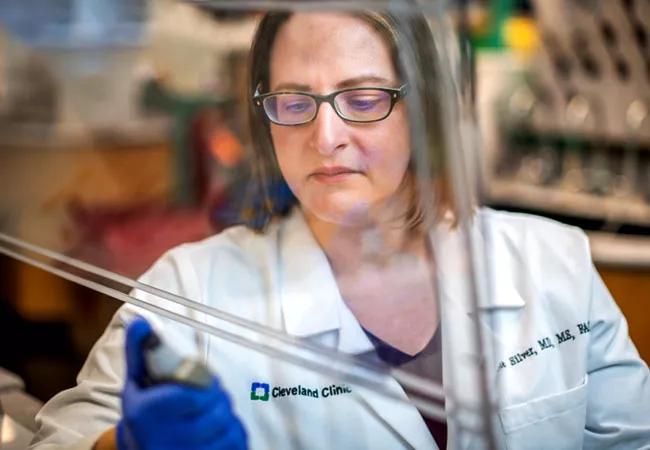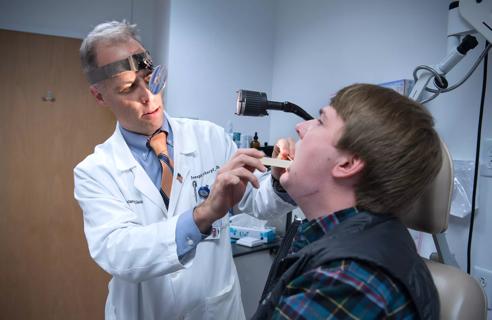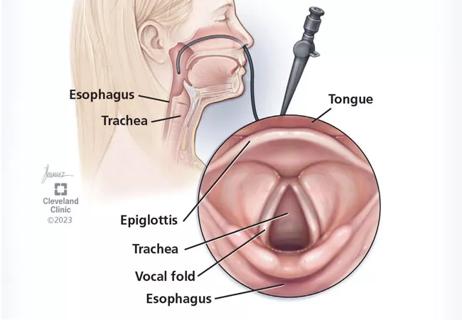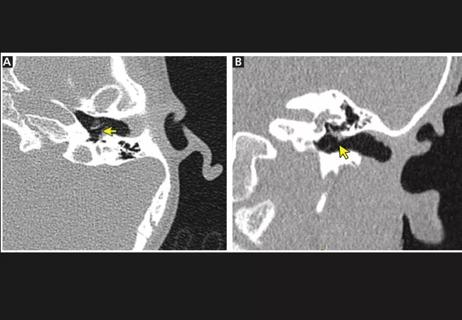Advertisement
Cleveland Clinic’s Director, Head and Neck Cancer Research discusses one of her recent projects and the role physician-scientists have in driving medicine forward

When Patrick Byrne, MD, became the Chair of Cleveland Clinic’s Head & Neck Institute, one of his major priorities was a recommitment to translational research. Bringing Natalie Silver, MD, MS, FACS, in as the Director, Head and Neck Cancer Research was a major step towards achieving that goal. Dr. Silver, who has been in the position since August 2021, brings not only a strong research background to the department, but her role as a head and neck cancer surgeon-scientist gives her a distinct understanding of how to bridge the work of a scientist with the work of a clinician.
Advertisement
Cleveland Clinic is a non-profit academic medical center. Advertising on our site helps support our mission. We do not endorse non-Cleveland Clinic products or services. Policy
“Cleveland Clinic has made a commitment to reach our full potential as a research institution,” says Dr. Byrne “This includes some very high-profile recruits and associated investments in oncology. Our Head and Neck Institute is therefore in the midst of a transformation, wherein we aim to leverage the strengths across our enterprise to push forward the boundaries of cancer care. Dr. Silver is one of our key recruits, and her work on cancer vaccines is perfect for us.”
After finishing her fellowship at MD Anderson, Dr. Silver went to the University of Florida where she was an assistant professor and the Head and Neck Cancer Disease Site Group Research Leader at the UF Health Cancer Center, for six years. In that role, she was responsible for the head and neck cancer clinical trials. While there, she also started her translational research lab with her research partner and mentor, Elias Sayour, MD, PhD.
“Although we have different backgrounds — Dr. Sayour is a pediatric neuro-oncologist, and I’m in adult head and neck surgical oncology — our desire to cure cancer, to impact people, to lead clinical trials, to translate this research from the bench to the bedside is what we share together.”
Over a few years, their lab developed RNA nano-vaccines that are personalized for head and neck cancer. “We have our own formulation that is patented, and it’s similar, in a way, to the COVID-19 vaccine,” explains Dr. Silver. “We use a lipid nanoparticles to encapsulate messenger RNA. But our formulation is different in that this is not a preventative vaccine. This isn’t something that you give to prevent COVID or cancer or an infectious disease. This vaccine is a potent immunotherapeutic agent that has the ability to reprogram a patient’s immune system against cancer.”
The vaccine design is based on taking a small sample from a patient’s tumor, which can be as little as a few hundred cancer cells. RNA is isolated from those cancer cells and a cDNA library is generated which is then amplified into mRNA for the vaccine. The mRNA, specific to the patient’s cancer transcriptome, is taken and packaged with lipid nanoparticles before it is delivered intravenously to a patient.
As a head and neck cancer surgeon, Dr. Silver has a strong interest in oral cancer treatments, which is where she is focusing her next efforts with the vaccine. “I was fortunate enough to get an NIH K08 Career Development Award, supporting my work in developing this vaccine for head and neck cancer,” she explains. “The project is really focused on preclinical translational work. So I do a lot of mouse work to perfect our formulation and understand the biology of the vaccine, and make sure that it’s safe for humans.”
Advertisement
Dr. Silver also is co-Principal Investigator for a feline personalized RNA nano-vaccine clinical trial ongoing at the University of Florida. Dr. Silver notes that these cats are not being tested on, or given cancer. Instead, these cats are pets that spontaneously get oral cancer. Dr. Silver’s veterinary partner Dr. Souza, DVM, MS, has treated four cats, similarly to how a human would be treated, and they are seeing positive results.
“Our cats are doing really well,” says Dr. Silver. “Generally, head and neck cancer in cats cause significant mortality; the overall lifespan is about one to four months, even with treatment. Our longest-term survivor is the first cat we ever treated, which was a year and a half ago. The cats haven’t had any serious adverse reactions, and we have found a safe and tolerable dose.”
The goal is to eventually move into human clinical trials. Following FDA Investigational New Drug approval for use in human brain cancer patients, the first patient with brain cancer will be treated in Florida very soon. Once that initial safety is established, the plan is to file an amendment with the FDA for head and neck cancer patient use. Then, the hope is to initiate a human clinical trial and a first-of-its-kind at the Cleveland Clinic for patients with head and neck cancer that are resistant to current therapies.
“Dr. Silver’s work has tremendous potential to break new ground in the fight against head and neck cancer,” says Dr. Byrne. “We aim for the first human clinical trial within two years.”
Beyond the research opportunities, Dr. Silver highlights a few things that attracted her to Cleveland Clinic. The opportunity to help her clinical colleagues bridge the gap between what physicians do on a daily basis with what happens in the most advanced setting of science over in the Center of Immunotherapy and Precision Immuno-oncology with Tim Chan, MD, PhD, was a big draw. Additionally, having Patrick Byrne MD, Head and Neck Institute Chair, as a mentor and leader was an important part in the attraction to Cleveland Clinic. Her background as an educator and the opportunity to train the next generation of scientists, especially surgeon-scientists, was also alluring.
“I know there are a lot of people who have an interest in science, but when they end up going down the surgical career pathway, it’s a different type of training,” says Dr. Silver. “I think a lot of people that originally want to do science, they maybe get discouraged because the surgical lifestyle is very challenging. So I think that by being who I am, doing both, I hopefully can help others see this path and learn more about it, and encourage other physician-scientists and surgeon-scientists to at least explore this type of career.”
Advertisement
Dr. Silver continues, “Not everyone can speak both the physician languages and the intense basic science language, and I think that we, as physician-scientists, are an important piece of the puzzle for how to really change the future of medicine. You really need both of these perspectives to communicate. I think the surgeon-scientist is really in a unique place to be able to help drive the questions and really apply the latest science to the clinic side and can serve as a bridge for true bench-to-bedside translational research.”
Advertisement
Advertisement

Looking at short-term outcomes in a high-risk population

Recommendations look to change mindset with CI referrals

Research aims to better understand the tumor immune micorenvironment

Research could help direct care pathways for patients with unexplained swallowing difficulties

Strong communication with the patient and a thorough approach are essential

Cleveland Clinic physicians weigh in

New research adds to understanding of an understudied link

The rare condition can cause structural damage if untreated